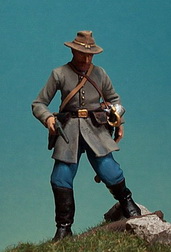HISTORICAL MINIATURES JOURNAL ISSUE NUMBER 10
PUBLISHED
BY GEORGE GRASSE
MODELING
TIPS
MILITARY MINIATURES
Tip 30)
Most company grade officers of the infantry in the American Civil War on
campaign and even into combat, often rolled their personal belongings in a greatcoat
or blanket and slung it across the chest, tying the ends together. It
proved of some value in thwarting sword wounds and could even stop a ball. These
were psychological assurances. By the time the article is rolled up and
tied, it takes on the appearance of blanket roll just like everyone else's.
Some of these articles were standard issue Government items and many were
privately purchased or received as gifts from the home front. When an
officer is "loaded" up with a blanket roll, map case, canteen,
haversack, pistol holster, cartridge box, and, all the while directing
troops in action, the finished figure is quite impressive. Some of these
items are included in a kit you might purchase. Other items can be found
in the spare parts tray or you may have to resort to scratch-building.
 |
 |
 |
 |
|
Confederate Officer, 6th Kentucky Infantry (El
Viejo Dragon EV4F46) |
Union Officer, 95th Pennsylvania "Gosline's
Zouaves" (El Viejo Dragon EV4F48) |
Union Officer, 7th U. S. Regular Infantry (El
Viejo Dragon EV4F46) |
U. S. Marine Corps Officer, Atlantic Coast
Operations (Shenandoah SHC036) |
WORLD WAR I AVIATION MODELING IN 1:48 SCALE
Tip 31)
In addition to piano music wire for rigging World War War
aircraft as explained in HM Journal 1 as Tip #4, another alternative is
monofilament thread which I use more frequently. I purchase the .005 size
available as "invisible thread" in fabric stores. The material is nylon
with any frayed ends and is available in dark metallic charcoal gray, perfect
for aircraft. If you need a larger size, visit a fishing sports store and
try larger scale lines. You probably won't find the size you need in an
appropriate color so they will have to be painted. The nice thing about this material is its instant
bonding to super glue.
Monofilament thread will go a long way
for an inexpensive spool. The size of .005 accommodates nearly all PE
turnbuckle parts. Just pass the thread through the eyelet, tie it off, pull it
taut, and add a drop of super glue. Add a clip on weight to keep the line
taut until dry. When the glue sets up (about twenty minutes), cut it off
with a sharp X-Acto blade.
One problem to anticipate with
monofilament thread is the turnbuckle hole is too small. Find a small #76
or smaller hand-twist drill to open up the hole Be careful when
tightening and avoid pulling the turnbuckle out of its "socket". Use one
pair of tweezers to hold the turnbuckle and another to hold the tread that needs
tightening. Pull against each over but on the same axis.
%20Nie%2028%20Nr%20607%2002a.jpg) |
%20AEG%20C.IV%2009.jpg) |
|
This is a 1:48 scale Nieuport 28 and shows all of
the techniques described above. The upper surface of the tail
unit is braced with .009 piano wire. The under side is braced
with flattened brass rod called "Strutz". The landing gear
cross bracing is .009 piano wire but the short vertical piece is
.007 piano wire. The model is suspended by .005 monofilament
thread which is normally used for wing bracing in this scale. |
This is a 1:48 scale AEG C.IV that illustrates
the use of .005 monofilament thread for inter wing rigging.
Notice the taut thread that has already be glued in place except for
two wires at the front which are drying and held taut by clips.
It's important to do just a few wires at a time and provide enough
room to allow gravity to work during the drying period. For
this model, all rigging threads were glued to the under side of the
top wing after the wing was painted. In this case, the under
side cannot be seen but it is a pale blue as shown on the landing
gear. The rigging threads pass through pre-drilled holes, are
glued, and then snipped off. Some touch-up is always needed so
be prepared to putty and sand. |
---------------------------------------------------------------------------------------------------------------------------------
GO TO?
© Copyright by George Grasse




%20Nie%2028%20Nr%20607%2002a.jpg)
%20AEG%20C.IV%2009.jpg)